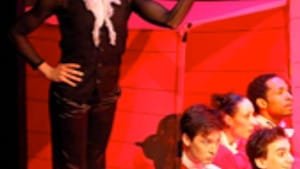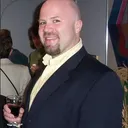Stay in the Loop
BSR publishes on a weekly schedule, with an email newsletter every Wednesday and Thursday morning. There’s no paywall, and subscribing is always free.
Dr. Seuss meets Fragonard
Ballet X: 'Striped Hat' and "Largo'

As part of its 2009 Spring Series, Ballet X presented two world premieres: Christine Cox's The Striped Hat, and Edwaard Liang's Largo. The moods of the two pieces could not have felt more different.
Cox's piece, inspired by the works of Dr. Seuss, opened on a rainy day, as two young siblings (Ballet X newcomers Laura Feig and Kevin Yee-Chan) battled restlessness (and each other) while looking out a window at the dreary weather outside. The pair danced about to stave off their boredom, prancing through pirouettes and leaps. Feig moved exquisitely through Cox's lighthearted choreography, but the pair needed to work on their timing.
Imagination quickly came to life in the person of a pink-feathered bird (Anitra Nurnberger as "Pet"), preening about gingerly on her pointe shoes as the siblings tried to trap her in their arms. But The Striped Hat didn't fully bloom until the appearance of the titular Lady in the Hat (Tara Keating). In a vaudeville manner that richly integrated Philadelphia actor Dito van Reigersberg's pantomimes into some jazz steps, Keating toyed with her hat and strutted about with supreme confidence, her smile radiating its own spotlight onto the stage as she pulled the two children from their chairs to mimic her strident movements.
A child's spirited imagination
Many ballets rely on pageantry to display the choreographer's skill and the dancers' technique. Here, Cox makes a story of pure pageantry both fun and vivid. The tinkling sound of the piano (courtesy of Mozart and Debussy) accentuated the light mood, as Cox's wonderfully entertaining piece found and then celebrated a child's spirited imagination. A red box appeared and chased the siblings across the stage; and later, five red pajama-clad "friends" sprang forth with a kite, flowers, pillows and, of course, plenty of hats. Laughing, the audience gave in to the fun, as if to agree with Dr. Seuss: "If only every rainy day had such sunshine and life to fill it!"
But the stage quickly became crowded as the children learned to play and dance in the rambunctious patterns of their new friends. Suddenly, the piece offered far too much to watch at once, and the ensemble's intentionally staggered asynchronization created even more visual dissonance. After the children packed their five friends back into the box, the friends reappeared inside a set of fabric-connected hoops and pranced about like a giant caterpillar.
Like her clowning friends who wrecked the room just as the rain ended, Cox provided some sharp but too-brief ensemble dancing, and what was once lively fun dancing descended into a silliness inappropriate even for Sesame Street.
A tableau of romantic coupling
Edwaard Liang's Largo, on the other hand, took inspiration from a more serious subject: Fragonard's series of paintings entitled Progress of Love. Liang's choreography matched Fragonard's pieces in displaying an amazing evolution of romantic coupling, creating a series of tableaux where dance took on all the richness of a painting through a build-up and culmination of emotion. And as in Herman Hesse's Narcissus and Goldmund, the key theme in Liang's work reminds that the expressions for suffering and sensuality are too often the same.
But Fragonard's charming, decorative paintings share more in common with Cox's playful work than with the somber and pained mood conveyed by Liang's Largo.
Shifting between ensemble sections for three couples and duets, Liang's opening segment finds women lying on the floor, moving their arms and legs to the sky, before being spun around and lifted up by the men. The pained expressions rarely departed from the dancer's faces as they executed the poised, measured movements; even much later, when Keating and Ja'Malik perform synchronized mid-air split kicks, the smiles on their faces couldn't shake the somber mood.
Locked in an embrace
The moving segment perfectly executed by Nurnberger and Gregory Brown only reinforces the agony of their coupled ecstasy. He cradles her about his upper body, trying to pull her close as she escapes and then returns, as Liang's choreography fuses sensual contact improvisation with the rigors of classical movements. The two dancers' bond— and later, those of the other couples— intensifies, each movement ending on a startling image, Nurnberger and Brown locked in an embrace (that reminded me of Aristophanes' "creation myth"). The entire work ended with the three couples spent and reclining into one another.
Some blame for Largo's somber mood lies with Liang's choice of music—the more contemplative measures in Bach's Goldberg Variations—and the costumes and staging. Dancers dressed in Martha Chamberlain's magenta bodysuits danced against a similar-colored background. Shelley Hicklin's lighting design— as if mirroring Bach's wizardry in finding endless diversity in only slight chord changes— found the endless array of hues that compose a single color.
In the program notes, Liang said he wanted to convey the serenity he felt when viewing Fragonard's work. Instead, he plumbed the somber emotions that accompany affection to find the surprising richness of melancholy. Watching his Largo— and for hours afterward— I felt like Shakespeare's Romeo, still pining for Rosaline before he met Juliet. And like the Bard's hero, I could have either fallen in love or committed suicide.
Cox's piece, inspired by the works of Dr. Seuss, opened on a rainy day, as two young siblings (Ballet X newcomers Laura Feig and Kevin Yee-Chan) battled restlessness (and each other) while looking out a window at the dreary weather outside. The pair danced about to stave off their boredom, prancing through pirouettes and leaps. Feig moved exquisitely through Cox's lighthearted choreography, but the pair needed to work on their timing.
Imagination quickly came to life in the person of a pink-feathered bird (Anitra Nurnberger as "Pet"), preening about gingerly on her pointe shoes as the siblings tried to trap her in their arms. But The Striped Hat didn't fully bloom until the appearance of the titular Lady in the Hat (Tara Keating). In a vaudeville manner that richly integrated Philadelphia actor Dito van Reigersberg's pantomimes into some jazz steps, Keating toyed with her hat and strutted about with supreme confidence, her smile radiating its own spotlight onto the stage as she pulled the two children from their chairs to mimic her strident movements.
A child's spirited imagination
Many ballets rely on pageantry to display the choreographer's skill and the dancers' technique. Here, Cox makes a story of pure pageantry both fun and vivid. The tinkling sound of the piano (courtesy of Mozart and Debussy) accentuated the light mood, as Cox's wonderfully entertaining piece found and then celebrated a child's spirited imagination. A red box appeared and chased the siblings across the stage; and later, five red pajama-clad "friends" sprang forth with a kite, flowers, pillows and, of course, plenty of hats. Laughing, the audience gave in to the fun, as if to agree with Dr. Seuss: "If only every rainy day had such sunshine and life to fill it!"
But the stage quickly became crowded as the children learned to play and dance in the rambunctious patterns of their new friends. Suddenly, the piece offered far too much to watch at once, and the ensemble's intentionally staggered asynchronization created even more visual dissonance. After the children packed their five friends back into the box, the friends reappeared inside a set of fabric-connected hoops and pranced about like a giant caterpillar.
Like her clowning friends who wrecked the room just as the rain ended, Cox provided some sharp but too-brief ensemble dancing, and what was once lively fun dancing descended into a silliness inappropriate even for Sesame Street.
A tableau of romantic coupling
Edwaard Liang's Largo, on the other hand, took inspiration from a more serious subject: Fragonard's series of paintings entitled Progress of Love. Liang's choreography matched Fragonard's pieces in displaying an amazing evolution of romantic coupling, creating a series of tableaux where dance took on all the richness of a painting through a build-up and culmination of emotion. And as in Herman Hesse's Narcissus and Goldmund, the key theme in Liang's work reminds that the expressions for suffering and sensuality are too often the same.
But Fragonard's charming, decorative paintings share more in common with Cox's playful work than with the somber and pained mood conveyed by Liang's Largo.
Shifting between ensemble sections for three couples and duets, Liang's opening segment finds women lying on the floor, moving their arms and legs to the sky, before being spun around and lifted up by the men. The pained expressions rarely departed from the dancer's faces as they executed the poised, measured movements; even much later, when Keating and Ja'Malik perform synchronized mid-air split kicks, the smiles on their faces couldn't shake the somber mood.
Locked in an embrace
The moving segment perfectly executed by Nurnberger and Gregory Brown only reinforces the agony of their coupled ecstasy. He cradles her about his upper body, trying to pull her close as she escapes and then returns, as Liang's choreography fuses sensual contact improvisation with the rigors of classical movements. The two dancers' bond— and later, those of the other couples— intensifies, each movement ending on a startling image, Nurnberger and Brown locked in an embrace (that reminded me of Aristophanes' "creation myth"). The entire work ended with the three couples spent and reclining into one another.
Some blame for Largo's somber mood lies with Liang's choice of music—the more contemplative measures in Bach's Goldberg Variations—and the costumes and staging. Dancers dressed in Martha Chamberlain's magenta bodysuits danced against a similar-colored background. Shelley Hicklin's lighting design— as if mirroring Bach's wizardry in finding endless diversity in only slight chord changes— found the endless array of hues that compose a single color.
In the program notes, Liang said he wanted to convey the serenity he felt when viewing Fragonard's work. Instead, he plumbed the somber emotions that accompany affection to find the surprising richness of melancholy. Watching his Largo— and for hours afterward— I felt like Shakespeare's Romeo, still pining for Rosaline before he met Juliet. And like the Bard's hero, I could have either fallen in love or committed suicide.
What, When, Where
Ballet X: The Striped Hat, by Christine Cox, and Largo, by Edwaard Liang. Through April 11, 2009 at Wilma Theater, 265 S. Broad St. (at Spruce). (215) 546-7824 or www.balletx.org.
Sign up for our newsletter
All of the week's new articles, all in one place. Sign up for the free weekly BSR newsletters, and don't miss a conversation.

 Jim Rutter
Jim Rutter